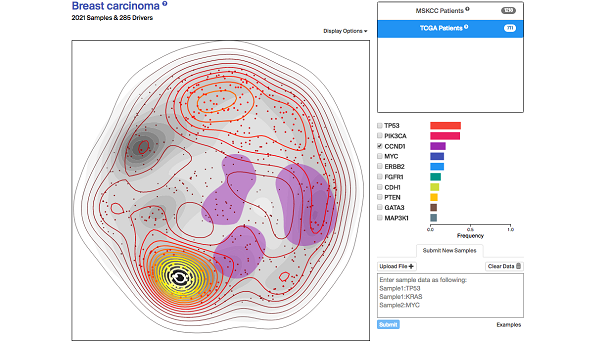
Cancer sequencing initiatives have generated genomic data for thousands of patients and tumor types, permitting the identification of hundreds of driver mutations responsible for uncontrolled cell proliferation. The analyses of these molecular profiles are, for the first time, enabling precision oncology, where patients are no longer stratified by the tissue of origin of their tumors but by their oncogenomic characteristics.
The accurate comparison of patient cohorts is crucial in evaluating their molecular diversity and, more importantly, in assessing whether information, such as treatment benefits or prognostic factors, learned from a reference group can be safely transferred to a new cohort.
With this aim, we have developed OncoGenomic Landscapes, a visualization tool that organizes tumor samples, and other cancer models, in a 2D space, enabling the comparison of large cohorts and capturing their molecular heterogeneity. Our resource includes information on the main cohorts published to date and, in addition, offers the possibility of mapping new samples and cohorts, providing an intuitive means to visualize user data and enrich it with knowledge transferred from the large corpus of cancer samples available today.
OncoGenomic Landscapes might also be useful in assessing the molecular representativity of different model systems (cell lines, organoids or patient derived xenografts) with respect to a reference clinical cohort, thus helping in the selection of the most appropriate pre-clinical model. Interestingly, we found that distances between patients in OncoGenomic Landscapes correlate with relevant clinical features, suggesting that they can guide the design of clinical basket trials, where patients are selected based on their oncogenomic profiles regardless of their specific tumor type.
Contextualizing individual patients in a more general landscape of human cancer is, we believe, a valuable aid for clinical oncologists trying to identify treatment opportunities, for example in a compassionate use basis for patients who have run out of standard therapeutic options.
To facilitate user-friendly access to the visualization tool for non-specialists, we have integrated it in an open web-server available here.
Comments